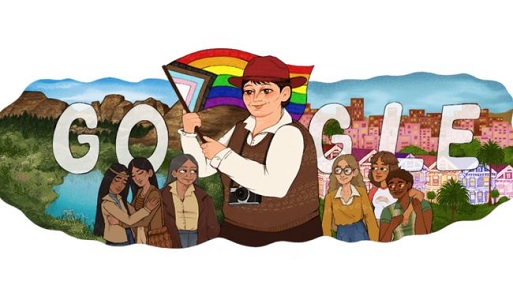Today, Google celebrates the life and work of Barbara May Cameron, a Native American photographer, filmmaker, and activist who captured the beauty and diversity of her people. She was also a pioneer in the Native American LGBTQIA+ movement, co-founding the organization Gay American Indians and advocating for their rights and visibility.
Who is Barbara May Cameron and why is she important?
Barbara May Cameron was born on October 18, 1954, in North Dakota. She belonged to the Hidatsa, Lakota, and Arikara tribes. She was one of the first Native American women to pursue a career in photography and film, using her camera as a tool to document the lives and struggles of Native American communities across the US. She was also a prominent activist for Native American and LGBTQIA+ rights, co-founding Gay American Indians and participating in various events and organizations that supported her causes.
What is the Google Doodle and who created it?

The Google Doodle is a tribute to Barbara May Cameron’s work and vision. It features some of her iconic photographs that showcase the diversity and resilience of Native American people. The doodle was created by guest artist Ashley Lukashevsky, an illustrator and visual artist based in Los Angeles. She said she was inspired by Cameron’s “passion for uplifting her community through art and activism”.
What are the main themes and messages of the doodle?
The doodle aims to celebrate Barbara May Cameron’s legacy and honor her contributions to Native American and LGBTQIA+ culture and history. The doodle also highlights some of the themes and messages that Cameron conveyed through her work, such as:
- The importance of preserving and celebrating Native American traditions, languages, and spirituality
- The diversity and beauty of Native American people, especially women, children, elders, and LGBTQIA+ individuals
- The resilience and strength of Native American communities in the face of oppression, discrimination, and violence
- The need for solidarity and collaboration among different groups and movements that share common goals and values
Barbara May Cameron’s life and work
How did she discover her passion for photography and film?
Barbara May Cameron discovered her passion for photography and film when she was a teenager. She received a camera as a gift from her mother, who encouraged her to pursue her artistic interests. She started taking pictures of her family, friends, and surroundings, developing a keen eye for capturing candid moments and emotions. She also developed an interest in film, watching movies at the local theater and learning about different genres and techniques.
What did she study at the American Indian Art Institute in Santa Fe, New Mexico?
Barbara May Cameron studied at the American Indian Art Institute (AIAI) in Santa Fe, New Mexico, from 1973 to 1975. AIAI was one of the first institutions that offered higher education opportunities for Native American artists. There, Cameron learned about various aspects of photography and film production, such as lighting, editing, sound, and storytelling. She also met other Native American artists who influenced her style and vision.
How did she document the lives and struggles of Native American communities?
Barbara May Cameron documented the lives and struggles of Native American communities through her photography and film projects. She traveled across the US, visiting different reservations, urban centers, ceremonies, protests, festivals, and gatherings. She took portraits of Native American people from various tribes, backgrounds, ages, genders, sexualities, and occupations. She also recorded interviews, speeches, songs, stories, and testimonies that reflected their experiences, perspectives, challenges, hopes, and dreams. She aimed to create a visual archive that would preserve and share the rich culture and history of Native American people.
What are some of her most famous works and projects?
Some of Barbara May Cameron’s most famous works and projects include:
- Heartbreak Soup (1979): A short documentary film that explores the lives of four young Native American women living in San Francisco. The film addresses issues such as racism, sexism, homophobia, poverty, addiction, violence, identity, love, friendship, family, and community.
- Children of Many Colors (1982): A photo exhibition that features portraits of Native American children from different tribes. The exhibition showcases the diversity and beauty of Native American youth culture.
- Lakota Woman: Siege at Wounded Knee (1994): A feature-length film that dramatizes the 1973 standoff between the American Indian Movement (AIM) activists and the US government at Wounded Knee. The film is based on the memoir of Mary Crow Dog (Lakota), who participated in the siege as a teenager.
- Native Nations: Standing Together for Civil Rights (2004): A photo book that documents the participation of Native American people in various civil rights movements throughout history. The book covers topics such as voting rights, land rights, environmental justice, sovereignty, self-determination, and cultural preservation.
Barbara May Cameron’s activism and legacy
How did she co-found Gay American Indians with activist Randy Burns in 1978?
Barbara May Cameron co-founded Gay American Indians (GAI) with activist Randy Burns (Northern Paiute) in 1978. GAI was one of the first organizations that focused on the needs and issues of Native American LGBTQIA+ people. GAI provided a space for Native American LGBTQIA+ people to express their identities, cultures, and histories. GAI also organized events, publications, workshops, and campaigns that raised awareness and advocated for their rights and visibility.
Must Visit: Argentina national football team vs Croatia national football team stats
How did she participate in organizing the Lesbian Gay Freedom Day Parade and Celebration in San Francisco from 1980 to 1985?
Barbara May Cameron participated in organizing the Lesbian Gay Freedom Day Parade and Celebration in San Francisco from 1980 to 1985. She was part of the committee that planned and coordinated the annual event that celebrated the diversity and pride of the LGBTQIA+ community. She also led the Native American contingent that marched in the parade, carrying banners, flags, drums, and feathers. She helped create a platform for Native American LGBTQIA+ people to showcase their culture and voice their demands.
How did she serve as the executive director of Community United Against Violence from 1987 to 1990?
Barbara May Cameron served as the executive director of Community United Against Violence (CUAV) from 1987 to 1990. CUAV is a grassroots organization that works to prevent and respond to violence against LGBTQIA+ people, especially those who are marginalized by race, class, gender, or immigration status. As the executive director, Cameron oversaw the operations, programs, staff, volunteers, and finances of CUAV. She also developed partnerships with other organizations and agencies that shared CUAV’s mission and vision.
You May Want to Read: Revolutionizing Connectivity: çeviit Innovation Unveiled in 2023
How did she advocate for Native American rights at the United Nations Commission on the Status of Women in 1995?
Barbara May Cameron advocated for Native American rights at the United Nations Commission on the Status of Women (UNCSW) in 1995. She was part of a delegation of Native American women who attended the UNCSW meeting in New York. She presented a statement that highlighted the challenges and achievements of Native American women in various fields, such as education, health, economy, politics, culture, and human rights. She also called for the recognition and respect of Native American sovereignty, self-determination, and treaty rights.
Conclusion
Barbara May Cameron’s life and work were marked by many challenges and achievements. She faced discrimination, violence, poverty, illness, and loss as a Native American woman who identified as lesbian. She also witnessed the oppression, injustice, and suffering of her people. However, she also overcame these obstacles with courage, creativity, compassion, and humor. She achieved recognition, respect, success, and happiness as a photographer, filmmaker, and activist. She also made a positive impact on her community, society, and humanity.
How does the Google Doodle honor her memory and vision?
The Google Doodle honors Barbara May Cameron’s memory and vision by showcasing some of her photographs that capture the essence of her work. The doodle also pays tribute to her birthday, which is today, October 18. The doodle celebrates her legacy as a Native American woman who used her art and activism to uplift her people and inspire others.
What can we learn from her example and message?
We can learn from Barbara May Cameron’s example and message that:
- We should embrace our identities, cultures, and histories and be proud of who we are
- We should use our talents, skills, and passions to express ourselves and make a difference
- We should document and share the stories and experiences of our people and communities
- We should stand up for our rights, justice, and dignity and support those who are oppressed or marginalized
- We should collaborate with others who have similar goals and values and create a network of solidarity and friendship
FAQ’s:
1. Who was Barbara May Cameron?
Barbara May Cameron was a Native American activist, poet, and photographer known for her contributions to the LGBTQIA+ and Native American communities.
2. What were some of Barbara May Cameron’s notable achievements?
Cameron co-founded the Gay American Indians, was an active participant in the Lesbian Gay Freedom Day Parade, and worked with organizations like the San Francisco AIDS Foundation.
3. What is the significance of Barbara May Cameron’s 69th birthday?
Barbara May Cameron’s 69th birthday was celebrated with a Google Doodle, highlighting her remarkable life and contributions.
4. How did Barbara May Cameron leave a legacy in the arts?
She worked with the American Indian Art Institute in Santa Fe, contributing to the preservation of Native American art and culture.
5. What is Barbara May Cameron’s message for the future?
Barbara May Cameron’s legacy reminds us to continue the fight for justice, equality, and human rights in society.


